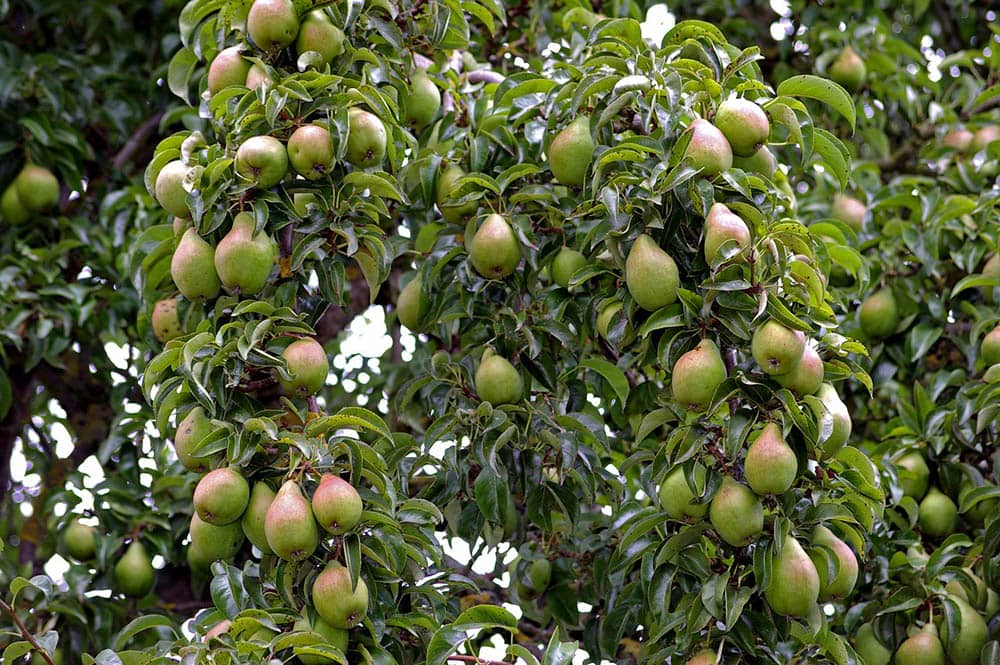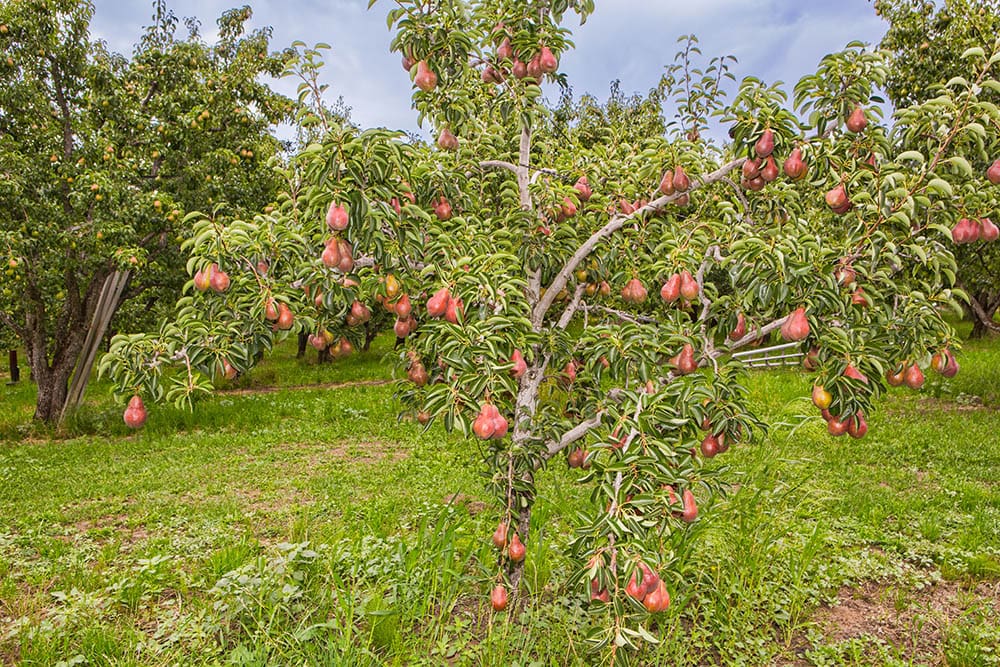15 Types of Pear Trees (with Pictures)
-

- Last updated:

Pear trees can be an exquisite addition to your garden or your home. They come in various shapes and sizes and are usually divided into fruit-producing and ornamental/non-fruiting types. Some of them are great for landscaping, while others offer delicious fruits.
Since there’s a lot of diversity in pear tree types, you need to know which one will best suit your needs. Finding the perfect kind for you can be difficult if you are unsure about where to begin. You came to the right place, and we will try to help with narrowing down your choices. Keep reading to learn more about 15 different types of pear trees and their characteristics.
The 15 Types of Pear Trees
Self-Fertile Pear Trees
1. Comice Pear Tree

The Comice pear tree is a smaller-sized pear tree native to France. It grows up to a height of 12 – 18 feet, and it can live up to 75 years, which is one of the most extended lifespans among pear trees. This pear tree type is self-fertile, but it can produce much better with a pollinator. The Comice pear tree’s fruits are firm, structured, and sweet.
2. Kieffer Pear Tree
The Kieffer pear tree is a mix of Asian Pear and Barlett. It produces large, yellow fruits that often have a rosy blush. This type of pear tree is hardy and self-fruitful. The Kieffer pear trees vary in size and can grow anywhere from 10–20 feet. They require about 350 chilling hours for the best growth.
3. Concorde Pear Tree

The Concorde pear tree comes from the UK. It is a self-fertile pear that doesn’t require pollinators for better production. This pear tree type can be 9–13 feet tall once it’s mature, and its fruits have a unique, elongated look with a vanilla-like taste. Its fruits are ripe and harvest-ready in mid-autumn.
Semi-dwarf Pear Trees
4. Sunrise Pear Tree
The Sunrise pear tree is a carefully made hybrid plant with impressive fire blight resistance. They are considered relatively small, with their height that reaches about 7–10 feet, and their spread at around 5–7 feet. This pear tree type requires 600 chill hours for maximum harvest results, usually in August.
5. Gorham Pear Tree
The Gorham pear tree is a type similar to Bartlett but slightly improved. It has more resistance when it comes to pests and scabs. It grows best in areas with a mild, dry climate. Their fruit is best when half-ripe, and they have a mild acid flavor. These are among the smallest pear trees, growing only 6 feet in height.
6. Seckel Pear Tree
The Seckel pear tree has an American heritage, and it was first grown there. Its height goes anywhere from 12–15 feet, making them fit into the semi-dwarf family species. People call Seckel fruits “sugar pears” or “candy pears” due to their sweet taste and golden look. You can harvest the fruits in late September for this sort of pear tree.
7. Anjou Pear Tree

The Anjou pear tree is a type that originates from Belgium, and it’s known for fruits that have a creamy, buttery taste. The trees spread into an oval form, from 8–20 feet of spread, and they can grow up to be 10–18 feet high. This species gets fully ripe in late September to mid-October, so that’s when the harvest can begin.
8. Bosc Pear Tree
The Bosc pear tree is a type that will provide you with fruit, even after all other types stop their ripeness. Their fruits are also known as “winter pears,” which blossom in late April and are harvest-ready in late September. Their mature height reaches around 12–18 feet, making them semi-dwarf plants.
Medium-Sized Pear Trees
9. Starkrimson Pear Tree
The Starkrimson pear tree was discovered in Missouri, and it has been providing people with juicy, sweet fruits ever since. The trees are 13–16 feet tall, resistant to cold weather. They have a distinctive look, with a bright red color when ripe. Starkrimson pear tree blooms in late spring, while the harvest happens around August.
10. Pineapple Pear Tree
Pineapple pear trees are majestic species of this plant, whose fruits resemble pineapple in taste. It blooms early in spring, and you can pick fruits around mid-July. They are best grown in warm areas, and they are another blight-resistant specimen. The heights they usually reach go from 15–20 feet.
11. Forelle Pear Tree

The Forelle pear tree is originally from Germany, and with years, they have become trendy in the US. Fruits from this pear type are high in potassium and fiber, making them a perfect choice for people with a healthy lifestyle. They provide a unique, cinnamon-like flavor. Their mature size varies from 12–16 feet.
12. Summercrisp Pear Tree
The Summercrisp pear tree is one of the hardy pear tree species. It was produced in the 1980s by the University of Minnesota. These interesting-looking pear fruits are crispy and small. It is cold-hardy, at a mature spread of about 12 feet. This pear tree type reaches 15–20 feet in height.
13. Bartlett Pear Tree

The Bartlett pear tree is one of the most popular species of pear trees in the US. Bartlett is another type of pear tree that requires chill hours to be better at producing, and for it, the usual need is around 600 hours on a temperature below 45° Fahrenheit. Their spread goes from 10–20 feet, while they can reach 12–20 feet.
Ornamental Pear Trees
14. Bradford Pear Tree
The Bradford pear tree is an ornamental species that can grow to incredible heights, anywhere from 30–50 feet. It has a distinctive, pyramidal form that spreads with age. In spring, you can witness a glorious bloom with thousands of white flowers. Although it has a beautiful look, this pear tree type is fragile in its structure.
15. Chanticleer Pear Tree
The Chanticleer pear tree is a charming, decorative type with a great form and
is resistant to breakage and blight. They are best when grown in warm climates and have stunning white flowers while blooming, making them a perfect landscape plant.
Conclusion
There are plenty of different pear tree types, each serving another purpose. We are sure that you’ll be able to find a perfect choice that fits your requirements and wishes. Determine if you want a smaller size pear tree, a medium-sized one, or if you just want one that will be the ornamental centerpiece of your backyard.
I mentioned both fruiting pear tree types and also ornamental ones in the beginning. Now, since all of there are fruiting types except Bradford and Chanticleer, I wasn’t sure if it’s okay to add that like one big title under here, and then have the subheadings by the way that they are categorized right now. Please advise and thank you!
Featured Image Credit: Pixabay
Contents

